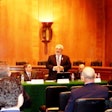Since 1998 I have taught the Basic Gangs class at the Regional Counterdrug Training Academy (RCTA) in Meridian, Miss. The majority of the criminal justice professionals who attend are from the Southern states, but in 2009 I was very surprised when two officers from the Columbus (Ohio) Police Department were in the class. One of the questions my partner Tom Nagy and I ask each student is: "Why are you here?" Both Columbus officers said their main focus is Somali gangs inside their city.
African gangs in the United States are nothing new. But they are becoming a more prevalent concern for law enforcement in cities that have significant African immigrant populations.
In the last decade Prince George's County, Md., saw an increase in the African immigrant population primarily from Nigeria, Sierra Leone, Ghana, Liberia, Ethiopia, Somalia, Eritrea, Senegal, and Gambia.
The Prince George's County Police Intelligence Unit has investigated Nigerian fraud rings involved in the Nigerian Letter or "419" fraud. Nigerian letter frauds combine the threat of impersonation fraud with a variation of an advance fee scheme in which a letter mailed from Nigeria offers the recipient the "opportunity" to share in a percentage of millions of dollars that the author, a self-proclaimed government official is trying to transfer illegally out of Nigeria.
Four years ago I investigated an African female gang operating from a Prince George's County High School. They named themselves the "Wild Stars" and got into fights with their African-American counterparts. The members all had roots in Sierra Leone.
According to the FBI's 2011 National Gang Threat Assessment, Somali gang presence has increased in several cities throughout the United States. Somali gangs are prevalent in Minneapolis-St. Paul, San Diego, and Seattle because of these cities' proximity to the Mexican and Canadian borders. Unlike most traditional street gangs, Somali gangs tend to align and adopt gang names based on clan or tribe, although a few have joined national gangs such as the Crips and Bloods.
West African countries, especially Nigeria, have been documented as transshipments centers for Golden Crescent heroin. After the heroin arrives in the U.S., it is sold only to one or two American distributors in a given area. Distribution networks are most active in New York City and Washington, D.C., and are operative in Chicago, Los Angeles, Houston, and Boston. Chicago street gangs have been documented as couriers and protection for Nigerian cartels.
Sudanese gangs in the United States have been expanding since 2003 and have been reported in Iowa, Minnesota, Nebraska, North Dakota, South Dakota, and Tennessee. Some Sudanese gang members have weapons and tactical knowledge from their involvement in conflicts in their native country.
Many people from foreign countries come to the United States for a better life. But history also tells us that the criminal elements from those foreign countries also come here, not so much for a better life but to increase their criminal enterprises.
Tony Avendorph retired in 2009 after 40 years in law enforcement, serving with the Illinois Department of Corrections, Los Angeles County Sheriff's Department, and Prince George's County (Md.) Police Department.



















